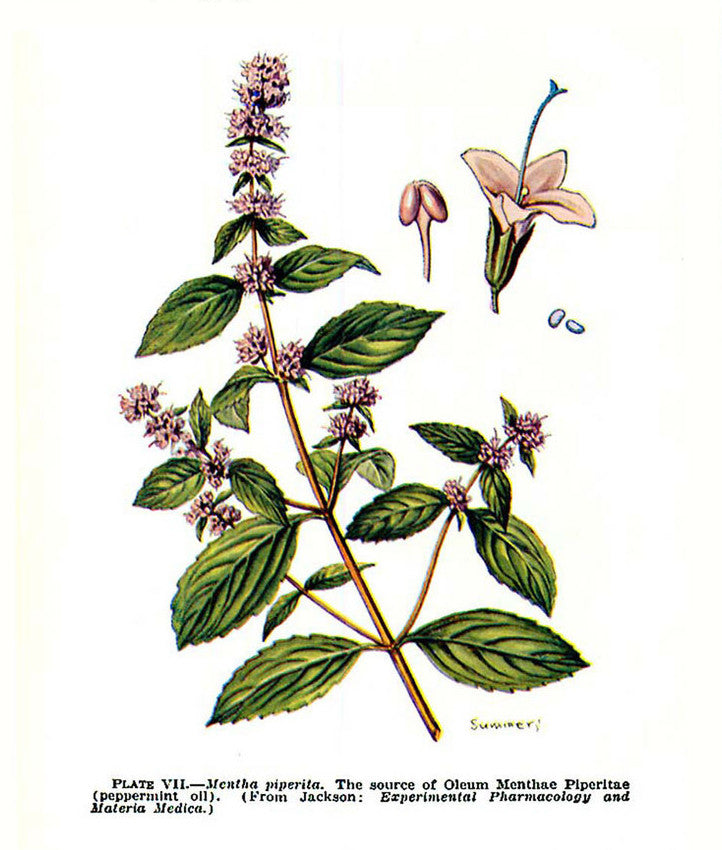Mentha piperita
Plant organ: aerial part
Optimal ranges of biochemical composition:
- Menthol 32-49%
- Chin 13-28%
- 1.8 Cineole (Eucalyptol) 3-8%
- Isomentone 2-8%
- Menthofuran 1-8%
- Neo-Menthol 2-6%
- Limonene 1-3%
- Beta-Caryophyllene 1-3.5%
- Pulegone 0.5-3%
- Trans-Tujanol 0.5-2%
General information and properties:
Mint essential oil is excellent for facilitating digestion, it is a general anti-inflammatory and antispasmodic tonic.
It is recognized by the World Health Organization as an effective migraine remedy.
Promotes gastric drainage and reduces gastric acidity. It has spasmolytic, anti-inflammatory, cholagogue, choleretic and carminative properties that give it clinically proven action on various digestive problems such as irritable bowel syndrome, intestinal spasms and functional dyspepsia.
Its use is recommended as a hepatoprotector to accompany strong essential oils such as Oregano, as is the case of its use in the treatment of Helicobacter pylori.
Menthol gives it refreshing, anti-inflammatory and analgesic properties. Menthol activates skin thermoreceptors causing deep analgesia. The thermoreceptors involved are TRPM8, sensitive to cold temperatures and involved in processes of inflammation, pain and itching in the skin (pruritus).
This analgesic property is circumscribed in a model of chronic neuropathic pain in the experimental phase.
correct traditional indications
Cardiology
hypotension
Mix 2 drops of Mint essential oil with a teaspoon of Honey or Olive oil. Apply under the tongue 3 times a day for a maximum period of 3 consecutive weeks.
Dermatology
Whitlow
Mix 1 drop of Peppermint essential oil with 1 drop of Tea Tree essential oil and dilute in 8 drops of Safflower vegetable oil. Apply to the affected area until completely absorbed into the skin.
Insect bite
Dilute 2 drops of Peppermint essential oil in 8 drops of Safflower vegetable oil. Apply to the affected area until fully absorbed into the skin.
gastroenterology
Irritable colon or colitis
Mix 3 drops of Mint essential oil with a teaspoon of honey. Take 3 times a day for a maximum period of 2 consecutive weeks.
Difficult digestion (dyspepsia)
Mix 3 drops of Mint essential oil with a teaspoon of honey or olive oil. Apply under the tongue 3 times a day for a maximum period of 3 consecutive weeks.
digestive spasms
Mix 3 drops of Mint essential oil with a teaspoon of Honey or Olive oil. Apply under the tongue 3 times a day for a maximum period of 3 consecutive weeks.
Gastritis
Mix 1 drop of essential oil of Mint with 1 drop of essential oil of Lemon in a teaspoon of Honey. Apply to the tongue on an empty stomach and before dinner.
Halitosis (bad breath)
Mix 1 drop of Mint essential oil with a teaspoon of Honey or Olive oil. Apply under the tongue 2 to 3 times a day for a maximum period of 3 consecutive weeks.
Hepato-pancreatic insufficiency
Mix 2 drops of Mint essential oil with a teaspoon of Honey and an infusion. Take after each meal for a maximum period of 3 consecutive weeks.
Transportation sickness (Dizziness)
Mix 1 drop of Peppermint essential oil in a teaspoon of Honey. Apply under the tongue.
Transportation sickness (Dizziness)
Inhale the Peppermint essential oil slowly and deeply directly from the bottle 3 to 5 consecutive times.
Nausea
Inhale slowly and deeply the essential oil of Eucalyptus Citriodora directly from the bottle 3 to 5 consecutive times; Repeat the process 2 to 3 times a day.
Nausea
Mix 1 drop of Peppermint essential oil with a teaspoon of Honey. Apply under the tongue.
Hangover
Dilute 2 drops of Peppermint essential oil in 8 drops of Safflower vegetable oil. Massage the forehead, temples, sinuses and neck until completely absorbed into the skin.
Neurology
Migraine of digestive origin or Migraine with undefined cause
Dilute 2 drops of Peppermint essential oil in 8 drops of Safflower vegetable oil. Massage the forehead, temples, sinuses and neck until completely absorbed into the skin.
Migraine of hormonal origin (Lack of estrogen)
Dilute 2 drops of Peppermint essential oil in 8 drops of Safflower vegetable oil. Massage the forehead, temples, sinuses and neck until completely absorbed into the skin.
Otorhinolaryngology
Sinusitis
Dilute 1 drop of Peppermint essential oil in 9 drops of Argan or Safflower vegetable oil. Apply to the forehead, temples, paranasal sinuses from bottom to top and on the nape of the neck. You can also add 1 drop of Eucalyptus globulus, Niaouli or Rosemary essential oil to verbenone.
Warnings on the use of essential oils:
The information on traditional use is not a substitute for the advice of a pharmacist or aromatherapy physician. Its use without attending to said recommendation will always be under your responsibility. If in doubt, it is recommended to consult your doctor. It is important to confirm the diagnosis of your disease or condition to make the best decision. It is especially important to review the contraindications and precautions for use of each essential oil. The indications and contraindications of an essential oil depend on its molecular composition. The traditional uses reported refer to essential oils and 100% pure vegetable oils with detailed information on origin, quality and specific molecular composition ranges for a SAFE AND EFFECTIVE AROMATHERAPY. THEY DO NOT APPLY TO ANY ESSENTIAL OIL THAT DOES NOT COMPLY WITH THIS INFORMATION! AROMATMA SAS is not responsible for inappropriate and/or abusive use of essential oils and vegetable oils. Allergy: Before using an essential oil, it is advisable to apply a drop on the inside of the elbow and wait 24 hours in order to demonstrate a possible allergic reaction. It is appropriate to consult the chapter entitled "Risks of using essential oil" if the icon "Allergy risks" appears.
SPIRITUAL EXERCISE RECOMMENDED BY DOCTOR SALIARMO
This is an exercise to expand your heart chakra, strengthen the immune system, and open our minds to the great vision that awaits us tomorrow:
Sit upright in a meditative posture. Apply a drop of chemotyped pure essential oil of Peppermint in the palm of your hand and rub your hands together. Take a deep breath while holding your hands in front of your nose.
Sit in your own hands until you calm down and your desires disappear over the horizon.
Then put your hands on either side of your chest at the level of your heart. Feel how the love from your heart flows into your hands.
Now, fully extend your arms to both sides. Touch your causal body and catch your vision that is available there. You may need to reach up your arms until you find it.
Now, bring your hands up to your head and completely envelop it with your vision. Allow your thoughts to bathe in it until you have a clear idea of how to achieve your full life. Put mint in your mind.
Bibliography:
De la Charie, T. et al. Website « Compagnie des Sens » – https://www.compagnie-des-sens.fr/
Franchomme, P., R. Jollois, and D. Pénoël. 2001. L'aromathérapie Exactly. Encyclopédie de L'utilisation Thérapeutique Des Huiles Essentielles. Editions Roger Jollois.
Zhiri A., Baudoux D. Huiles essentielles chémotypées et leurs synergies.
Passport Santé. Website https://www.passeportsante.net/
Scott A. Johnson, 2015. Evidence-based essential oil therapy the ultimate guide to the therapeutic and clinical application of essential oils (EBEO)
https://vanessences.fr/content/28-huile-essentielle-encens-bienfaits-proprietes-utilisation
Image source:
Jackson, D.E. (1913). Experimental Pharmacology and Materia Medica, 1939. CV Mosby Co., St. Louis. THIS JOURNAL , 5 , 479.

